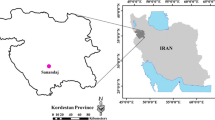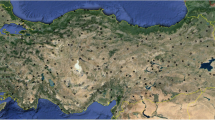Abstract
Soil temperature has an important role in agricultural, hydrological, meteorological and climatological studies. In the present research, monthly mean soil temperature at four different depths (5, 10, 50 and 100 cm) was estimated using artificial neural networks (ANN), adaptive neuro-fuzzy inference system (ANFIS) and gene expression programming (GEP). The monthly mean soil temperature data of 31 stations over Iran were employed. In this process, the data of 21 and 10 stations were used for training and testing stages of used models, respectively. Furthermore, the geographical information including latitude, longitude and altitude as well as periodicity component (the number of months) was considered as inputs in the mentioned intelligent models. The results demonstrated that the ANN and ANFIS models had good performance in comparison with the GEP model. Nevertheless, the ANFIS generally performed better than ANN model.






Similar content being viewed by others
References
Bilgili M (2010) Prediction of soil temperature using regression and artificial neural network models. Meteorol Atmos Phys 110:59–70
Bilgili M, Sahin B, Sangun L (2013) Estimating soil temperature using neighboring station data via multi-nonlinear regression and artificial neural network models. Environ Monit Assess 185:347–358
Ferreira C (2001) Gene expression programming: a new adaptive algorithm for solving problems. Complex Syst 13:87–129
Gao Z, Horton R, Wang L, Liu H, Wen J (2008) An improved force-restore method for soil temperature prediction. Eur J Soil Sci 59:972–981
Haykin S (1998) Neural networks-a comprehensive foundation, 2nd edn. Prentice-Hall, Upper Saddle River, pp 26–32
Hu Q, Feng S (2003) A daily soil temperature dataset and soil temperature climatology of the contiguous United States. J Appl Meteorol 42:1139–1156
Jackson T, Mansfield K, Saafi M, Colman T, Romine P (2008) Measuring soil temperature and moisture using wireless MEMS sensors. Measurement 41:381–390
Jang JSR (1993) ANFIS: adaptive-network-based fuzzy inference system. IEEE Trans Syst Man Cybern 23:665–685
Katterer T, Andren O (2009) Predicting daily soil temperature profiles in arable soils in cold temperate regions from air temperature and leaf area index. Acta Agric Scand Sec B Soil Plant Sci 59:77–86
Khalili K, Tahroudi MN, Mirabbasi R, Ahmadi F (2016) Investigation of spatial and temporal variability of precipitation in Iran over the last half century. Stoch Environ Res Risk Assess 30:1205–1221
Kim S, Singh VP (2014) Modeling daily soil temperature using data-driven models and spatial distribution. Theor Appl Climatol 118:465–479
Kisi O, Sanikhani H (2015a) Modelling long-term monthly temperatures by several data-driven methods using geographical inputs. Int J Climatol 35:3834–3846
Kisi O, Sanikhani H (2015b) Prediction of long-term monthly precipitation using several soft computing methods without climatic data. Int J Climatol 35:4139–4150
Kisi O, Tombul M, Kermani MZ (2015a) Modeling soil temperatures at different depths by using three different neural computing techniques. Theor Appl Climatol 121:377–387
Kisi O, Sanikhani H, Kermani MZ, Niazi F (2015b) Long-term monthly evapotranspiration modeling by several data-driven methods without climatic data. Comput Electron Agric 115:66–77
Kisi O, Sanikhani H, Cobaner M (2016) Soil temperature modeling at different depths using neuro-fuzzy, neural network, and genetic programming techniques. Theor Appl Climatol. doi:10.1007/s00704-016-1810-1
Mehdizadeh S, Behmanesh J, Khalili K (2016) Comparison of artificial intelligence methods and empirical equations to estimate daily solar radiation. J Atmos Sol Terr Phys 146:215–227
Mehdizadeh S, Behmanesh J, Khalili K (2017) Application of gene expression programming to predict daily dew point temperature. Appl Therm Eng 112:1097–1107
Mihalakakou G (2002) On estimating soil surface temperature profiles. Energy Build 34:251–259
Nahvi B, Habibi J, Mohammadi K, Shamshirband S, Al Razgan OS (2016) Using self-adaptive evolutionary algorithm to improve the performance of an extreme learning machine for estimating soil temperature. Comput Electron Agric 124:150–160
Piccarreta M, Lazzari M, Pasini A (2015) Trends in daily temperature extremes over the Basilicata region (southern Italy) from 1951 to 2010 in a Mediterranean climatic context. Int J Climatol 35:1964–1975
Tabari H, Sabziparvar AA, Ahmadi M (2011) Comparison of artificial neural network and multivariate linear regression methods for estimation of daily soil temperature in an arid region. Meteorol Atmos Phys 110:135–142
Tabari H, Talaee PH, Willems P (2015) Short-term forecasting of soil temperature using artificial neural network. Meteorol Appl 22:576–585
Talaee PH (2014) Daily soil temperature modeling using neuro-fuzzy approach. Theor Appl Climatol 118:481–489
Wu W, Tang X-P, Guo N-J, Yang C, Liu H-B, Shang Y-F (2013) Spatiotemporal modeling of monthly soil temperature using artificial neural networks. Theor Appl Climatol 113:481–494
Yassin MA, Alazba AA, Mattar MA (2016) Artificial neural networks versus gene expression programming for estimating reference evapotranspiration in arid climate. Agric Water Manag 163:110–124
Yilmaz T, Ozbek A, Yilmaz A, Büyükalaca O (2009) Influence of upper layer properties on the ground temperature distribution. J Therm Sci Technol 29:43–51
Zahiri A, Eghbali P (2012) Gene expression programming for prediction of flow discharge in compound channels. J Civ Eng Urban 2:164–169
Zanetti SS, Sousa EF, Oliveira VPS, Almeida FT, Bernard S (2007) Estimating evapotranspiration using artificial neural network and minimum climatological data. J Irrig Drain Eng 133:83–89
Zheng D, Hunt ER Jr, Running SW (1993) A daily soil temperature model based on air temperature and precipitation for continental applications. Clim Res 2:183–191
Author information
Authors and Affiliations
Corresponding author
Rights and permissions
About this article
Cite this article
Mehdizadeh, S., Behmanesh, J. & Khalili, K. Evaluating the performance of artificial intelligence methods for estimation of monthly mean soil temperature without using meteorological data. Environ Earth Sci 76, 325 (2017). https://doi.org/10.1007/s12665-017-6607-8
Received:
Accepted:
Published:
DOI: https://doi.org/10.1007/s12665-017-6607-8




